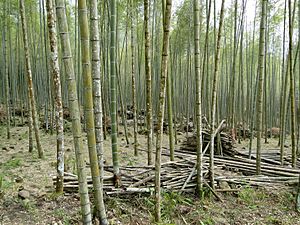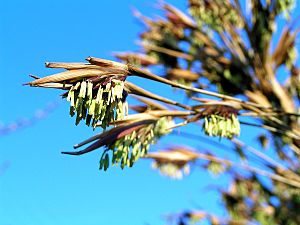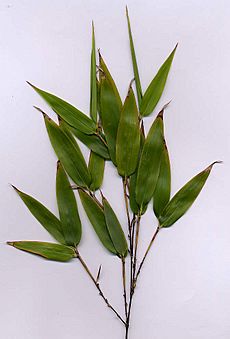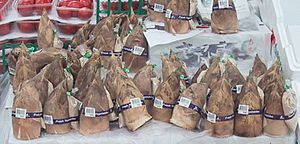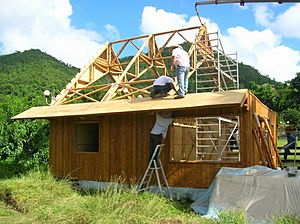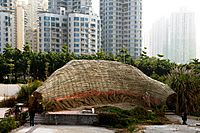Bamboo facts for kids
Quick facts for kids Bamboo |
|
|---|---|
 |
|
| Bamboo forest in Kyoto, Japan | |
| Scientific classification | |
| Kingdom: | |
| Division: | |
| Class: | |
| Order: | |
| Family: | |
| Subfamily: |
Bambusoideae
|
Bamboo is a type of giant grass. There are over 1,400 different kinds, also called species, of bamboo. These species belong to 115 different groups, known as genera. All bamboos have strong, wood-like stems. You can find bamboo growing mostly in Africa, America, and Asia. It can also grow quite easily in Europe.
Bamboo usually grows in groups or "clumps." However, some types can spread out a lot, with their underground stems, called runners, reaching up to 40 meters (130 feet) long! Bamboo is one of the fastest-growing plants on Earth. Some have been recorded growing over 1.2 meters (47 inches) in just one day! But for most bamboos grown in gardens, they grow about 3 to 5 centimeters (1-2 inches) each day.
Almost all bamboo species have hollow stems. These stems are divided into sections by "joints" or nodes. The stem can be as wide as 30 centimeters (about a foot). Each joint has a small bud on one side. Not all of these buds grow into branches, but some do. This makes bamboo special because it's one of the few grasses that has branches. Bamboo plants rarely flower. Some types flower only once in their lifetime and then die. The space between two joints on a bamboo stem is even used as a traditional Japanese unit of measurement called shaku.
Contents
Amazing Growth of Bamboo
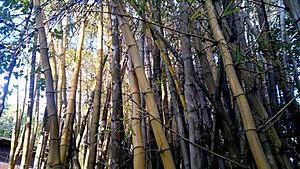
Bamboo is known for being one of the fastest-growing plants. Some reports say it can grow 100 centimeters (about 39 inches) in just 24 hours! How fast it grows depends on the soil, weather, and the specific type of bamboo. In milder climates, many bamboos grow about 3 to 10 centimeters (1-4 inches) per day during their growing season. Long ago, during the late Cretaceous period, huge fields of bamboo grew in what is now Asia.
Since bamboo is a type of grass, it grows back quickly after being cut. This means there's usually plenty of it, and harvesting it doesn't harm the environment much. Unlike trees, individual bamboo stems, called culms, sprout from the ground already at their full thickness. They grow to their full height in just one growing season, which lasts about three to four months.
During these months, each new shoot grows straight up. It doesn't grow branches until it reaches most of its final height. After that, branches grow from the joints, and leaves appear. In the second year, the soft walls of the culm slowly get harder. By the third year, the culm becomes even stronger. At this point, it's considered a fully grown culm.
Many types of bamboo that grow in warm, tropical places will die if the temperature drops to freezing. However, some tougher types, called temperate bamboos, can survive temperatures as low as -29°C (-20°F). These hardy bamboos can grow in very cold areas. Even if their leaves fall off and the parts above ground die, their roots will survive. New shoots will then grow again the next spring. In warmer places, some tough bamboos stay green all year round.
Bamboo's Rare Flowering Cycle
Most bamboo species do not flower often. In fact, many bamboos only flower every 65 or even 120 years! When they do flower, all the plants of a certain species around the world flower at the same time. This is called "mass flowering" or "gregarious flowering." The longest known mass flowering period is 130 years, seen in the species Phyllostachys bambusoides. When this happens, all plants of the same type flower together, no matter where they are or what the weather is like. After flowering, the bamboo plants usually die.
When bamboo flowers in large amounts, it creates many seeds. This can cause a big increase in the number of rodents, like rats, in the forests. More rodents can then lead to more diseases and food shortages for people living nearby.
The flowering produces many seeds, which usually hang from the ends of the branches. These seeds grow into new bamboo plants. These new plants might look exactly like the ones that flowered. Or, they might have new features, like different colored stems or stripes.
Animals That Eat Bamboo
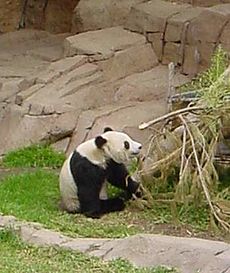
Soft bamboo shoots, stems, and leaves are the main food for several animals. The giant panda in China eats mostly bamboo, making up 99% of its diet! The red panda from Nepal and the bamboo lemurs from Madagascar also rely on bamboo for food. As mentioned, rats will eat the bamboo fruits. Mountain gorillas in Africa eat bamboo and have even been seen drinking fermented, alcoholic bamboo sap. Chimpanzees and elephants in the region also eat bamboo stalks.
The larvae (young insects) of the bamboo borer moth (Omphisa fuscidentalis) live in Laos, Myanmar, Thailand, and Yunnan Province, China. They eat the soft inside of living bamboo. These caterpillars are considered a special food in those areas.
Growing and Harvesting Bamboo
Bamboo for Building
Some of the larger types of bamboo, especially those in the Phyllostachys group, are known as "timber bamboos." These are harvested from both cultivated farms and wild areas.
How Bamboo is Harvested
Bamboo used for building needs to be cut when its stems are strongest. It's also important to harvest when the sugar levels in the bamboo's sap are low. High sugar content can attract pests and make the bamboo rot faster.
Bamboo is usually harvested following these steps:
- Life Cycle of the Culm: Each individual bamboo stem, or culm, lives for about 5 to 7 years. It's best to let culms reach this age before harvesting them fully. Cutting out older, decaying culms helps new bamboo grow better by giving it more light and resources. Well-cared-for bamboo clumps can produce three to four times more than wild ones.
- Annual Cycle: New bamboo growth happens during the wet season. Disturbing the bamboo during this time can harm the next crop. Also, during the rainy season, sap levels are highest and then drop as the dry season approaches. Harvesting right before the wet season can also damage new shoots. So, the best time to harvest is at the end of the dry season, a few months before the wet season begins.
- Daily Cycle: During the middle of the day, photosynthesis is at its peak, meaning there's the most sugar in the sap. This makes it the worst time to harvest. Many traditional farmers believe the best time to harvest is at dawn or dusk, during a waning moon.
Removing Sap from Bamboo
After bamboo is harvested, the sap needs to be removed. This process is called leaching. In many parts of the world, the sap levels in cut bamboo are reduced by leaching or by letting the plant use up its sugars after being cut.
Here are some ways this is done:
- Cut bamboo is lifted off the ground and leaned against the rest of the clump. It stays there for one to two weeks until its leaves turn yellow. This allows the plant to use up all its sugars.
- Another method is similar, but the bottom of the culm stands in fresh water, either in a large barrel or a stream. This helps to leach out the sap.
- Cut culms are placed in a running stream and held down for three to four weeks.
- Water is pumped through the freshly cut culms to force out the sap. This method is often used along with injecting some kind of treatment into the bamboo.
When bamboo is leached with water, it is dried slowly and evenly in the shade. This prevents the outer skin from cracking, which helps keep pests away.
How long bamboo lasts in construction depends on how well it's handled. This includes everything from planting and harvesting to transport, storage, design, building, and care. Bamboo harvested at the right time but then left on the ground or exposed to rain will break down just as quickly as bamboo that was harvested incorrectly.
Bamboo for Gardens
There are two main ways bamboo grows: "clumping" and "running." Clumping bamboo spreads slowly. Its roots simply expand the main root mass, much like other garden grasses. "Running" bamboos, however, need more care when planted because they can spread very quickly. They spread mainly through their roots and underground stems, called rhizomes. These can spread far underground and send up new culms to the surface. How much running bamboo spreads depends on the species, the soil, and the climate. Some can send out runners several meters a year, while others stay in the same area for a long time. If not managed, they can spread into nearby areas.
Bamboo rarely flowers, and it's hard to predict when it will happen. The time between flowering varies a lot between species. Once a bamboo plant flowers, it usually weakens and often dies completely. Even though some bamboo species are always flowering somewhere, people who want to grow specific types of bamboo usually get them as pieces of already-growing plants, rather than waiting for seeds.
Many Uses of Bamboo
Cooking with Bamboo
The hollow inside of larger bamboo stalks is often used for cooking in many Asian cultures. Soups are boiled, and rice is cooked directly in fresh bamboo stalks over a flame. Sometimes, steamed tea is pressed into bamboo hollows to make compressed blocks of Pu-erh tea. Cooking food in bamboo is said to give it a subtle and special taste.
Bamboo is also widely used for cooking tools in many cultures, and it's used to make chopsticks. Today, some people see bamboo tools as an environmentally friendly choice compared to other manufactured utensils.
Bamboo in Medicine
Bamboo is used in Chinese medicine to treat infections and help with healing.
Building with Bamboo
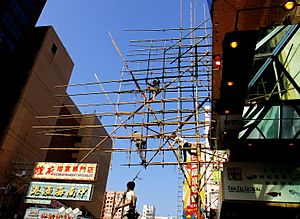
Bamboo is a natural composite material, much like wood. It is very strong for its weight, which makes it useful for building structures.
Historically, bamboo has been a traditional building material in South Asia, East Asia, and the South Pacific. It's also used in parts of Central and South America. In China and India, bamboo was used to support simple suspension bridges. This was done by making cables from split bamboo or by twisting whole, flexible bamboo culms together. One such bridge in China was mentioned in writings from 960 AD and might have existed since the third century BC, thanks to constant repairs.

Bamboo has also been used for scaffolding for a long time. While this practice has been stopped in China for buildings over six stories, it is still used for skyscrapers in Hong Kong. In the Philippines, the nipa hut is a common type of simple housing that uses bamboo. Its walls are made of split and woven bamboo, and bamboo poles are used for support. In Japanese architecture, bamboo is mainly used for decorative parts in buildings, like fences, fountains, and gutters. This is because good quality timber is readily available there.
Different shapes can be made by guiding bamboo as it grows. Square bamboo sections are made by pressing the growing stalk inside a square mold. Arches can also be created by forcing the bamboo to grow into the desired shape. This costs much less than shaping regular wood timber. Older methods, like using heat and pressure, can also be used to bend or flatten cut bamboo stalks.
Bamboo can be cut and pressed into sheets and planks. This process involves cutting stalks into thin strips, flattening them, boiling and drying them. Then, they are glued, pressed, and finished. This has been done in China and Japan for a long time. In the mid-1990s, businesses in the West started selling laminated bamboo flooring. Products made from laminated bamboo, like flooring, cabinets, furniture, and decorations, are now very popular. They have moved from special stores to big retailers like The Home Depot. The bamboo goods industry, which also includes small items and fabric, was expected to be worth $25 billion by 2012. The quality of laminated bamboo varies depending on the maker and how mature the bamboo was when harvested (six years is considered best). The strongest products claim to be up to three times harder than oak wood, but others might be softer than standard wood.
Bamboo used for building should be treated to protect it from insects and rot. A common treatment is a mix of borax and boric acid. Another method involves boiling cut bamboo to remove the starches that attract insects.
Bamboo has been used to strengthen concrete in places where it is common. However, there is some debate about how effective it is. Bamboo does have the necessary strength, but untreated bamboo will swell when it absorbs water from the concrete, which can cause cracks. Several steps must be followed to prevent this problem.
Many groups, businesses, and universities are studying how to use bamboo as an environmentally friendly building material. In the United States and France, you can find houses made entirely of bamboo. These homes are resistant to earthquakes and cyclones and are certified internationally. In Bali, Indonesia, the Green School, a school for kids from kindergarten to high school, is built completely from bamboo. This shows off bamboo's beauty and its benefits as a sustainable resource. There are three ISO standards for bamboo as a building material.
Bamboo for Clothes
The fibers of bamboo are very short, less than 3 millimeters. This means they cannot be naturally made into yarn. The usual way textiles labeled as "bamboo" are made is by turning the fibers into rayon using many chemicals. This process breaks down the fibers with chemicals like lye, carbon disulfide, and strong acids. Then, they are pushed through special machines to form threads. Stores have sold both these products as "bamboo fabric" to take advantage of bamboo's eco-friendly image. However, the Canadian Competition Bureau and the US Federal Trade Commission started stopping this practice in mid-2009. They require these products to be labeled as rayon, with the option to add "from bamboo."
Bamboo for Paper
Bamboo fiber has been used to make paper in China since ancient times. High-quality, handmade paper is still produced in small amounts. Coarse bamboo paper is still used to make spirit money in many Chinese communities.
Bamboo pulps are mainly made in China, Myanmar, Thailand, and India. They are used for printing and writing papers. The most common bamboo species used for paper are Dendrocalamus asper and Bamboo bluemanea. It's also possible to make dissolving pulp from bamboo. The average fiber length of bamboo is similar to hardwoods. However, bamboo pulp acts more like softwood pulps because its fibers vary greatly in length. With modern tools, it's now possible to identify the best fiber-producing species even when they are young. This helps in making pure products.
Other Uses of Bamboo
Bamboo has a long history of being used for Asian furniture. Chinese bamboo furniture has its own unique style, based on thousands of years of tradition. Several companies now offer bamboo bicycles and skateboards.
Because it is flexible, bamboo is also used to make fishing rods. The split cane rod is especially valued for fly fishing. Bamboo has traditionally been used in Malaysia to make a firecracker called a meriam buluh or bamboo cannon. Sections of bamboo, about four feet long, are cut. A mix of water and calcium carbide is put inside. The gas that forms, called acetylene, is lit with a stick, making a loud bang. Bamboo can be used to remove salt from seawater, a process called water desalination. A bamboo filter helps remove the salt.
In East Timor, food is cooked in bamboo over a fire. This dish is called Tukir.
Bamboo in Asian Culture
Bamboo's long life makes it a symbol of long life in China. In India, it symbolizes friendship. Because it flowers so rarely, bamboo flowers are sometimes seen as a sign that a famine is coming. This might be because when bamboo flowers, it produces many seeds, which can cause rat populations to boom. These rats then eat and destroy a lot of the local food supply. The most recent mass flowering began in May 2006 (see Mautam). Bamboo is said to bloom this way only about every 50 years.
In Chinese culture, bamboo, the plum blossom, the orchid, and the chrysanthemum are together called the Four Gentlemen. These four plants also represent the four seasons. In Confucian ideas, they represent four qualities of a noble person. The pine, the bamboo, and the plum blossom are also admired for being strong in harsh conditions. They are known as the "Three Friends of Winter" in Chinese culture. The "Three Friends of Winter" are traditionally used in Japan to rank things, like sushi sets or rooms at a traditional inn. Pine is the highest rank, bamboo is second, and plum is third.
Bamboo in Mythology
Several Asian cultures, including those from the Andaman Islands, believe that humans came from a bamboo stem.
In Philippine mythology, a famous creation story tells of the first man, Malakás ("Strong"), and the first woman, Maganda ("Beautiful"). They each came out of one half of a split bamboo stem on an island. This island was formed after a battle between the Sky and the Ocean. In Malaysia, a similar story tells of a man who dreams of a beautiful woman while sleeping under a bamboo plant. He wakes up, breaks the bamboo stem, and finds the woman inside. The Japanese folktale "The Tale of the Bamboo Cutter" tells of a princess from the Moon who appears from a shining bamboo section. In Hawaii, bamboo ('ohe) is a form of the Polynesian creator god Kāne.
A bamboo cane is also the weapon of the Vietnamese legendary hero, Saint Giong. He grew up magically and instantly at age three because he wanted to free his land from invaders. An old Vietnamese legend, "The Hundred-knot Bamboo Tree", tells of a poor young farmer who loved his landlord's daughter. The farmer asked to marry her, but the proud landlord would not let his daughter marry a poor farmer. The landlord gave him an impossible task: he had to bring a "bamboo tree of 100 nodes". But Buddha appeared to the farmer and told him that such a tree could be made from 100 nodes from different trees. Buddha gave him four magic words to connect the many bamboo nodes: Khắc nhập, khắc xuất, which means "joined together immediately, fell apart immediately." The farmer returned to the landlord and demanded his daughter. Curious to see such a long bamboo, the landlord magically joined to the bamboo when he touched it, as the young farmer said the first two magic words. The story ends with the happy marriage of the farmer and the landlord's daughter after the landlord agreed to the marriage and asked to be separated from the bamboo.
In a Chinese legend, the Emperor Yao gave two of his daughters to the future Emperor Shun to test if he could rule. Shun passed the test of managing his household with two wives. So, Yao made Shun his successor, instead of his unworthy son. Later, Shun drowned in the Xiang River. The tears his two sad wives cried fell on the bamboos growing there. This explains the origin of spotted bamboo. The two women later became goddesses.
Bamboo as a Writing Surface
Bamboo was widely used in early China for writing documents. The oldest surviving examples of these documents, written in ink on bamboo strips tied together with string, date back to the fifth century BC during the Warring States period. However, older texts mention that some form of these bamboo slips was used as early as the late Shang period (around 1250 BC).
Bamboo or wooden strips were the main writing material during the Han dynasty. Many excavated examples have been found. Later, paper started to replace bamboo and wooden strips for most uses. By the fourth century AD, bamboo slips were mostly no longer used for writing in China. Several paper companies still rely on bamboo forests for their production. For example, Ballarpur paper mills in Chandrapur, India, use bamboo to make paper.
Bamboo as a Weapon
Bamboo is used in several martial arts from East and South Asia.
- In the ancient Tamil martial art of Silambam, fighters would hit each other quickly with bamboo sticks.
- In the Japanese martial art Kendo, bamboo is used to make the Shinai sword.
- Bamboo is used to craft the world's longest bows, the Yumi, and the arrows used in the Japanese martial art Kyudo.
- In traditional archery, the longbow and recurve bow limbs are sometimes made with flat bamboo. It's also used to make excellent weapons for bowhunting and target archery.
- A bamboo stick can be sharpened at one end to make a simple spear.
- The first weapons that used gunpowder, like the fire lance, were made of bamboo.
Other Cultures and Bamboo
The Bozo people of West Africa get their name from the Bambara phrase bo-so, which means "bamboo house."
Bamboo is the national plant of St. Lucia.
Images for kids
-
Woman gathering bamboo shoots, woodblock print by Suzuki Harunobu, 1765
-
Khao lam (Thai: ข้าวหลาม) is glutinous rice with sugar and coconut cream cooked in specially prepared bamboo sections of different diameters and lengths
-
Bamboo is extensively used for fishing and aquaculture applications on the Dayu Bay in Cangnan County, Zhejiang
-
A cylindrical bamboo brush holder or holder of poems on scrolls, created by Zhang Xihuang in the 17th century, late Ming or early Qing Dynasty – in the calligraphy of Zhang's style, the poem Returning to My Farm in the Field by the fourth-century poet Tao Yuanming is incised on the holder.
-
Kadomatsu made of bamboo for Japanese New Year
-
Მოსო ბამბუკი.JPG
Phyllostachys pubescens in Batumi Botanical Garden
-
Bamboo forest in Isère, France
-
Bamboo forest at the Rutgers Gardens, North Brunswick, New Jersey
See also
 In Spanish: Bambú para niños
In Spanish: Bambú para niños


